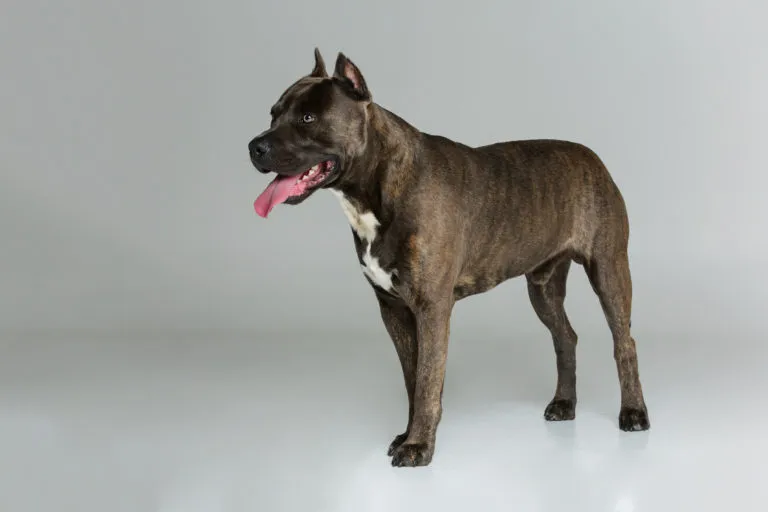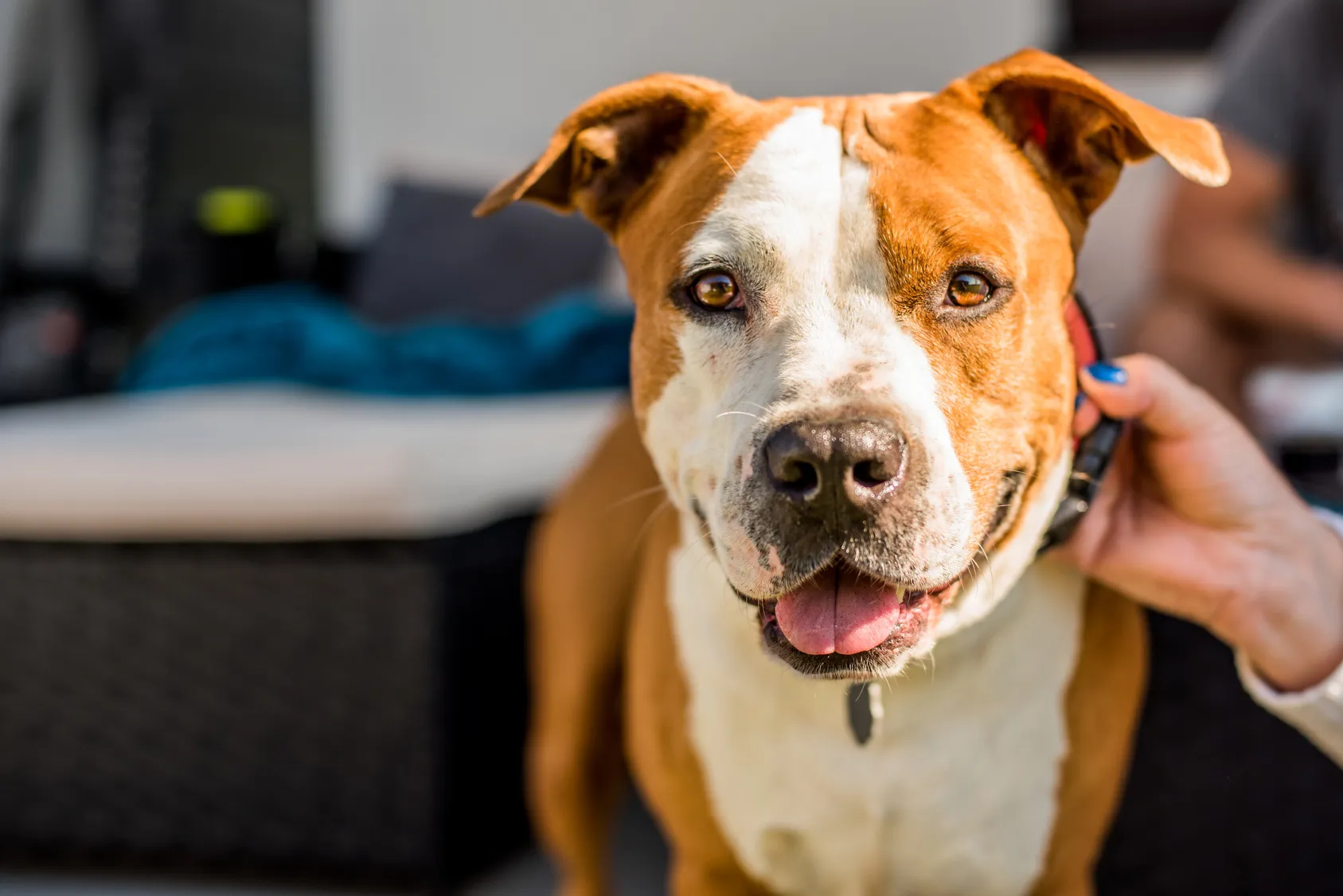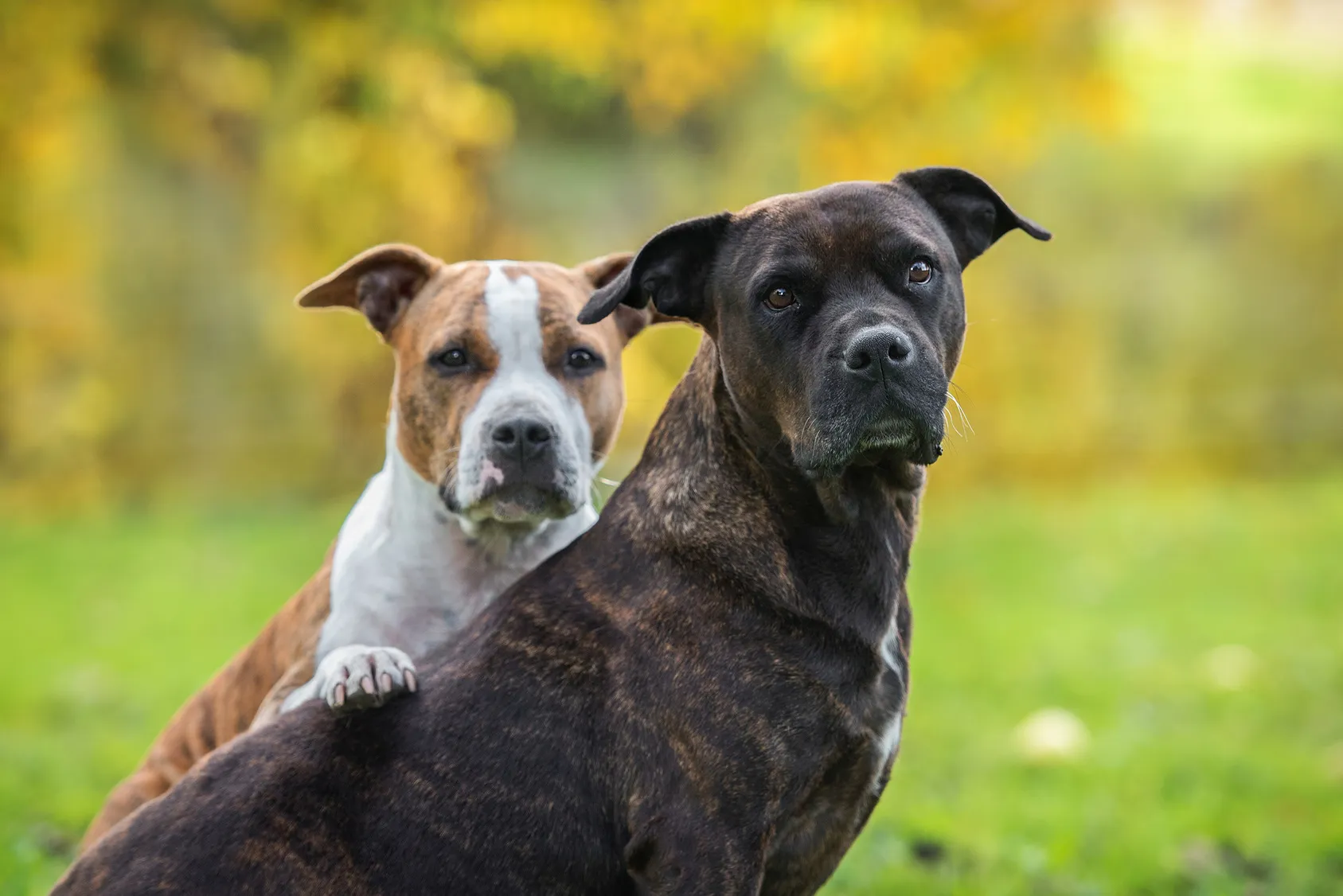Beagle
The Beagle's short legs can be deceiving – this medium-sized dog keeps you on your toes and is always full of surprises! This friendly breed is active, fearless and extremely clever.
The American Staffordshire Terrier, known in short as the “Am Staff”, polarises opinion like hardly any other breed. It is classed as a “dangerous fight dog” in some European countries, where it is forbidden to keep one or only permitted depending on certain conditions, but in Britain it is highly esteemed as a “nanny dog”. This demonstrates once again that the reason a dog behaves in an aggressive and fierce manner is usually the person holding it on the lead. The breed deserves to be viewed impartially, because an intelligent, dynamic and forever loyal companion lies behind the many prejudices.

© svetography / stock.adobe.com
A brawny dog with a muscular and compact body, an American Staffordshire is an imposing sight to behold. It is between 43 and 48cm in height and weighs up to 23kg. Its dark eyes are set in a wide head and the ears are mainly semi-upright – floppy ears are undesirable. Thankfully, the practice of docking staff ears that was so popular in many European countries is forbidden nowadays.
The breed’s short and shiny fur can be admired in almost every colour shade possible. However, a lack of colour pigmentation in the nose, the black/tan colour found with the Doberman breed and many white spots, which can accompany a genetic disposition for deafness, are considered undesirable.
 © Przemyslaw Iciak / stock.adobe.com
© Przemyslaw Iciak / stock.adobe.com
The American Staffordshire Terrier has mainly been bred for dogfights. Its ancestors likely ended up in the USA with British immigrants after leaving the UK around 1860. In the second half of the 19th century, this muscular breed was used for largely commercial dog fights taking place in the USA. The breeding objective was to produce brave, fierce and tenacious fight dogs. Thankfully, there are famous American Staffordshire Terriers beyond the world of dog fights: for instance, the dog Petey in the popular children’s series “Little Rascals”. Nowadays, Am Staffs are mainly kept as family and guard dogs. In Britain, American Staffordshire Terriers are highly prized family dogs, or “nanny dogs”. They are often also deployed as social dogs in care homes, where they brighten up the days for residents with their good-natured and playful manner. Their sovereignty and endurance make them excellent rescue dogs.
The breed traces back to the Bull and Terrier group that was widespread in Britain in the 18th century and predominantly bred for dog fights. The breed name American Staffordshire Terrier features the place of their roots, the British Stafford. After horrific dog fights were banned in Britain in 1835, some descendants reached the USA thanks to British settlers and were used there in fights once again. The dogs deployed as guard dogs for farms were bred to be even bigger over the course of time in order to increase their chances in fights against coyotes and wolves. Towards the end of the 19th century, there were more and more American Staffordshire Terrier lovers who wanted their dogs to feature in exhibitions, not fights. In order to differentiate from the English Staffordshire Bull Terrier, the breed was renamed the American Staffordshire Terrier in 1969 and was recognised by the FCI in 1971. This ended the confusion surrounding the names Pit Bull Terrier, American Bull Terrier and Stafford Terrier, all of which were used at the same time.
Many people react sceptically or with aversion when an American Staffordshire Terrier approaches them. “Isn’t that a fight dog?” or “Just don’t come too near me with that thing!” are some of the more harmless reactions. The negative image surrounding these former fight dogs has certainly been enhanced by the fact that for a long time it was en vogue for a certain clientele to take out a dog primed to be fierce on a spiked lead as a status symbol. The fact that a dog’s degree of dangerousness is principally determined by who’s holding it on the lead demonstrates the contrasting manner in which the breed is kept in Britain and the US, where the Am Staff is recognised as an ideal family dog thanks to its nanny dog traits.
The negative connotations of the breed’s past lead to some idiosyncrasies in Europe regarding housing or importing the dogs. In many countries, the American Staffordshire is classed as a so-called “fight dog” and keeping one is either forbidden or only allowed depending on certain conditions. For instance, there is a travel ban in place for the breed in countries such as France or Hungary, whilst the dog’s family tree needs to be presented for entry to the Netherlands, and in Spain special registration requirements with the local authorities need to taken into account. Restrictions and bans have led to Am Staffs hardly being present in some countries, such as France, Sweden and the Netherlands. Even in Germany, keeping this breed is subject to compliance with many conditions and linked to higher costs in many federal states.
What’s the typical American Staffordshire Terrier like, then? In spite of its past, the breed is highly suitable as a family dog. It is characterised by its strong attachment to its family and often shows great affection towards children in particular. Conflict can flare up when dealing with other dogs, particularly those that are insecure, because the Am Staff comes across as very dominant due to its past. But this very past also induces great loyalty to its people, since the dogs always had to be able to be withdrawn from fights without biting its owners. This loyalty made it possible for the American Staffordshire Terrier to be exploited for gruesome fights in the first place. Otherwise, they are dynamic lively dogs with a real need for exercise. Their attentive and playful nature means that they love to express to the full also catches the eye. A well-trained Am Staff kept appropriately occupied is a perfect family dog that doesn’t bark much. Incidentally, studies and statistics on bites prove that American Staffordshire Terriers are just as placid as popular Golden Retrievers – even if this has clearly not been accepted in many European bureaucratic offices.
 © Grigorita Ko / stock.adobe.com
© Grigorita Ko / stock.adobe.com
The breed is generally very robust and enjoys the best of health. In some instances, skin problems in the form of allergies can emerge, but they are usually easy to get to grips with by changing the diet. There are a few isolated cases of hip dysplasia or cardiac insufficiency. When they are well looked after, American Staffordshire Terriers have a life expectancy of around 12 years.
American Staffordshire Terriers are no dogs for beginners, because they are clever and quickly exploit typical novice errors. Resulting dominance problems can be difficult to correct and can unfortunately also lead to dangerous consequences. However, if you’re consistent and give your dog the feeling that it’s being led with authority, you’ll find a firm friend for life in the Am Staff.
You need to be able to offer these activity-loving dogs the right environment. Due to their size, strength and urge for movement, American Staffordshire Terriers aren’t suitable for life in a city apartment – they love to frolic around playfully. These curious dogs also like to have their “own” garden, but watch out as their urge for discovery could get out of hand. To be on the safe side, it’s best to have a garden surrounded by a 1.60m-high fence to prevent escape attempts, as they can often show an unexpected talent for jumping. American Staffordshire Terriers are happiest living with sporty people who like outdoor activity, love long walks and wish to go on the odd bike tour with their (adult) dog.
Before your American Staffordshire Terrier moves in with you, you should definitely get informed about possible provisions in your municipality on keeping a “fight dog” or dog classified as “dangerous”. Gather precise information on possible requirements in your region (muzzle, certificate of competence or good conduct), more specifically whether the Am Staff can be kept at all. Last but not least, there may be increased taxes on so-called “fight dogs” that include the Am Staff in several regions, for instance, some German federal states, in which you pay much more than the usual dog tax. For this reason, numerous friendly Am Staffs end up in animal homes because the owners cannot afford the annual dog taxes amounting to a four-digit price tag.
There are a few things to mull over before you decide to take on a new four-legged family member. For example, the costs for basic equipment (lead, basket, blankets, brushes) and the regular costs for appropriate dog food, as well as injections and health check-ups. Further vet costs can emerge if diseases are present. You should also be aware that taking on a dog of this breed could potentially be contraversial amongst your circle of acquaintances or be met with rejection. However, it can be a pleasant experience to slowly but surely do away with prejudices and generalisations surrounding the breed! Consider how your dog can be looked after if you go on holiday or fall ill. Although many hotels across Europe now host dogs too, there might be limits on entry requirements and overnight accommodation for American Staffordshire Terriers. You should definitely also clarify if any human family members are potentially allergic to dog hair. When purchasing a puppy, you should ideally look for a suitable dog school before it moves into your home that offers playtime for puppies, since this can be a real positive to give the American Staffordshire Terrier social interaction.
Grooming an American Staffordshire Terrier is a breeze. Brushing once a week is sufficient, but your dog will surely enjoy extra stroking sessions with a rubber comb. Another advantage is that the hairs end up in the comb, not all over your home.
The American Staffordshire Terrier needs consistent but loving instruction. Since they are very intelligent, they immediately exploit training weaknesses. The dog owner should never show fear or, for instance, tolerate dominant behaviour patterns during the dog’s puberty phase. The dog has to learn that the human rules the roost, so consistent training and assured leadership are essential. An advantage for training is the breed’s “will to please” – the dog wants to please the owner. Their special mimicry is often mentioned, as clever Am Staffs have the proverbial puppy dog eyes and make use of them to achieve their objectives. The owner has to remain steadfast in these cases.
 © Grigorita Ko / stock.adobe.com
© Grigorita Ko / stock.adobe.com
American Staffordshire Terriers want lots of activity. To this end, almost all types of dog sports are suitable, from agility with flyball or obedience to training as a therapy dog. It’s advisable to avoid guard dog work, which can unfavourably bring out the breed’s genetically entrenched ferocity. Am Staffs love long walks, and adult dogs enjoy running alongside a bike. Ball games and playing fetch also wear out these powerhouses. An occupied Am Staff then treasures its well-earned free time for cuddle sessions with its favourite people or in a cosy basket.
A responsible breeder is an absolute necessity for American Staffordshire Terriers, as they pay attention to the dogs’ temperament to thrive as a beloved family dog. Pay a visit to the home of the breeder, who should be a member of a dog club or association, before purchasing a puppy and get a picture of how the dogs are housed and of their parents and siblings. Good breeders are themselves curious and like to grill potential buyers with questions about living environment and leisure activities. This is a good sign, as it shows they really care about the future of their wards! You should also be able to discuss health-related questions with the breeder.
American Staffordshire Terriers can also be found at numerous animal welfare organisations if you aren’t looking for a puppy. Some associations have even specialised in placing so-called “fight dogs” and can give you excellent advice on which dog is best suited to your family. An older dog from an animal home can be hugely enriching, but you should make sure you are well informed about its character and, if possible, its background. An American Staffordshire Terrier with inadequate training should only go to a very experienced owner!
If you’re well informed and want to given an American Staffordshire Terrier a new home, you will certainly experience great joy living with this clever powerhouse and will be able to observe how this dog’s pleasant nature happily does away with prejudice with a wag of the tail.
We wish you and your loyal American Staffordshire Terrier a wonderful life together!
The Beagle's short legs can be deceiving – this medium-sized dog keeps you on your toes and is always full of surprises! This friendly breed is active, fearless and extremely clever.
The Golden Retriever is still one of the most popular dog breeds, especially with families. It is defined not just by its docility, but shows numerous other qualities too. Read in the following article everything you need to know about the Golden Retriever.
The German Shepherd is one of the most popular utility dog breeds in the world, though the willing-to-learn and people-focused nature of these versatile dogs also makes them suitable for family life.